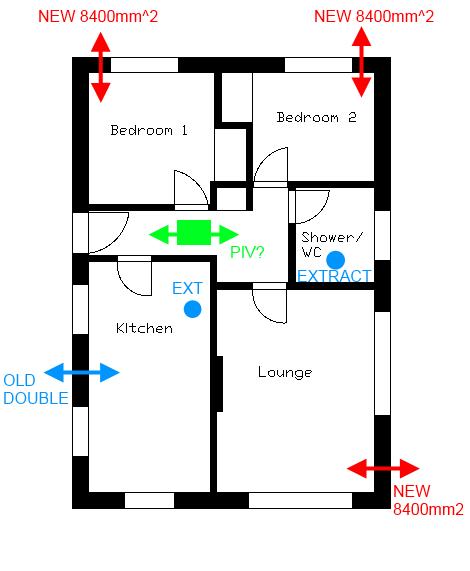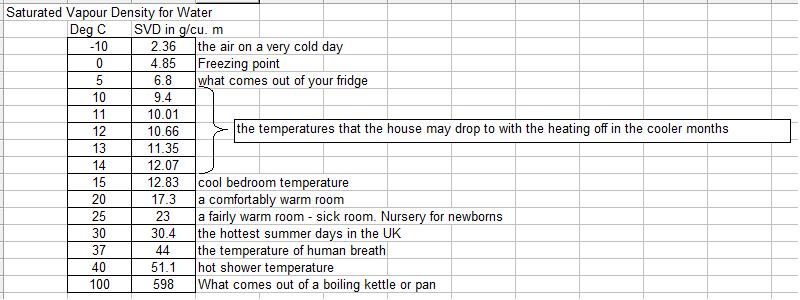I have a small 2 bedroom bungalow with limited ventilation provision and I'm currently experiencing problems with condensation running down the double glazed windows. The windows do not have trickle vents, and I have been using the "lock open" position 24/7 to mitigate the problems, but don't like this due to the security risk.
I do not dry washing inside, and have an extractor over the shower which is ducted outside and runs during and for at least 30 minutes after a shower with the window wide open. Loft insulation was topped up by previous owners, as well as cavity wall insulation. Some evidence of historic mould was seen on North facing walls, but these don't appear to get damp now - just the window glass.
I have done a quick roughly to scale sketch of the floor plan. The right hand wall (as drawn) is North East facing. The worst rooms for condensation are those labelled Bedroom 2 and the Lounge. Relative humidity hovers around 65-70% with 19-20°C. With the windows locked open for 24 hours and heating on full, temperature was 24°C with 50% RH.
There is currently a double terracotta air brick in the kitchen, about 5 foot from the floor level. (plus another single air brick behind the cupboards) Everything in blue exists already. Red is what I'm proposing as additional.
The front door shown here opens to a double glazed porch area (not drawn). As such I'm not sure that there is any significant air change when coming and going to/from work.
I have considered 3 options:
1. Trickle Vents - very cheap, but have concerns that these don't provide sufficient area, and also about outside noise.
2. Fit 3 additional wall vents in the positions shown in red each providing 8400mm2 unrestricted area. I am considering the Ryton AAC125HP, for reduced noise transmission.
3. Fit a PIV unit in the loft (Nuaire Drimaster) in the position shown in green. But then would this require some trickle vents or wall vents be fitted into the windows anyway, to be effective.
The area provided by the three new wall vents seems to provide sufficient ventilation for the size of property. I've positioned them diagonally opposite the door in each room - is this optimal?
Any ideas welcome. Thanks!
I do not dry washing inside, and have an extractor over the shower which is ducted outside and runs during and for at least 30 minutes after a shower with the window wide open. Loft insulation was topped up by previous owners, as well as cavity wall insulation. Some evidence of historic mould was seen on North facing walls, but these don't appear to get damp now - just the window glass.
I have done a quick roughly to scale sketch of the floor plan. The right hand wall (as drawn) is North East facing. The worst rooms for condensation are those labelled Bedroom 2 and the Lounge. Relative humidity hovers around 65-70% with 19-20°C. With the windows locked open for 24 hours and heating on full, temperature was 24°C with 50% RH.
There is currently a double terracotta air brick in the kitchen, about 5 foot from the floor level. (plus another single air brick behind the cupboards) Everything in blue exists already. Red is what I'm proposing as additional.
The front door shown here opens to a double glazed porch area (not drawn). As such I'm not sure that there is any significant air change when coming and going to/from work.
I have considered 3 options:
1. Trickle Vents - very cheap, but have concerns that these don't provide sufficient area, and also about outside noise.
2. Fit 3 additional wall vents in the positions shown in red each providing 8400mm2 unrestricted area. I am considering the Ryton AAC125HP, for reduced noise transmission.
3. Fit a PIV unit in the loft (Nuaire Drimaster) in the position shown in green. But then would this require some trickle vents or wall vents be fitted into the windows anyway, to be effective.
The area provided by the three new wall vents seems to provide sufficient ventilation for the size of property. I've positioned them diagonally opposite the door in each room - is this optimal?
Any ideas welcome. Thanks!



